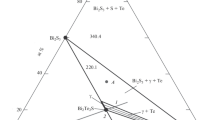Abstract
Raman-scattering, electronic-absorption, and ESR spectra have been used to determine the states of bismuth and the structures of the compounds formed in molten chloride systems; it is found that BiCl4 − with Td symmetry are formed in BiCl3-Li, K/Cleu melts, while a Bi0-BiCl3-Li, K/Cleu melt produces the BiCl4 − ⇄ BiCl3 + Cl−; BiCl3 + Bi0 ⇄ Bi2Cl3 equilibria with the formation of Cl− the quasitetrahedral
ion in the second stage, which has a metal-bond and a single unpaired electron.
Similar content being viewed by others
Literature cited
S. V. Volkov and K. B. Yatsimirskii, Molten-Salt Spectroscopy [in Russian], Naukova Dumka, Kiev (1977).
Yu. K. Delimarskii and O. G. Zarubitskii, Electrochemical Refining of Heavy Metals in Ionic Melts [in Russian], MetaIlurgiya, Moscow (1975).
L. F. Kozin, Theoretical Aspects of Electrochemical Kinetics: Collection [in Russian], V. S. Kublanovskii (ed.), Naukova Dunka, Kiev (1984). pp. 3–38.
R. P. Oerfel and R. A. Plane, Inorg. Chem.,6, No. 11, 1960–1967 (1967).
J. T. Kenney and F. X. Powell, J. Phys. Chem.,72, No. 9, 3094–3097 (1968).
N. J. Bierrum, C. R. Boston, and G. P. Smith, Inorg. Chem.,6, No. 6, 1162–1172 (1967).
Yu. K. Delimarskii, Ionic-Melt Electrochemistry [in Russian], Meta11urgiya, Moscow (1978).
J. D. Corbett, Inorg. Chem.,7, No. 2, 198–208 (1968).
S. V. Volkov and N. I. Buryak, Teor, Éksp. Khim.,7, No. 2, 275–278 (1971).
S. V. Volkov, N. P. Evtushenko, and K. B. Yatsimirskii, ibid.,12, No. 1, 111–115 (1976).
S. V. Volkov, V. F. Grishchenko, and Yu. K. Delimarskii, Salt-Liquid Coordination Chemistry [in Russian], Naukova Dumka, Kiev (1977).
Yu. K. Delimarskii, The Theoretical Principles of Ionic-Melt Electrolysis [in Russian], Meta11urgiya, Moscow (1986).
F. Cotton and J. Wilkinson, Modern Inorganic Chemistry [Russian translation], Part 2. Mir, Moscow (1969).
Yu. K. Delimarskii, S. V. Volkov, O. G. Zarubitskii, et al., Ukr. Khim. Zh.,53, No. 1, 3–9 (1987).
S. V. Volkov, V. S. Naumov, and A. A. Omel'chuk, ibid.,50, No. 2, 154–157 (1984).
J. H. R. Clarke and R. E. Hester, Inorg. Chem.,8, No. 5, 1113–11l6 (1969).
Additional information
Institute for General and Inorganic Chemistry, Academy of Sciences of the Ukrainian SSR, Kiev. Translated from Teoreticheskaya i Éksperimental'naya Khimiya, Vol. 27, No. 3, pp. 311–315, May–June, 1991. Original article submitted September 12, 1988.
Rights and permissions
About this article
Cite this article
Volkov, C.V., Buryak, N.I., Kozin, V.F. et al. Spectra and structure for Bi0-BiCl3-Li, K/Cl. Theor Exp Chem 27, 270–273 (1991). https://doi.org/10.1007/BF01372492
Issue Date:
DOI: https://doi.org/10.1007/BF01372492




